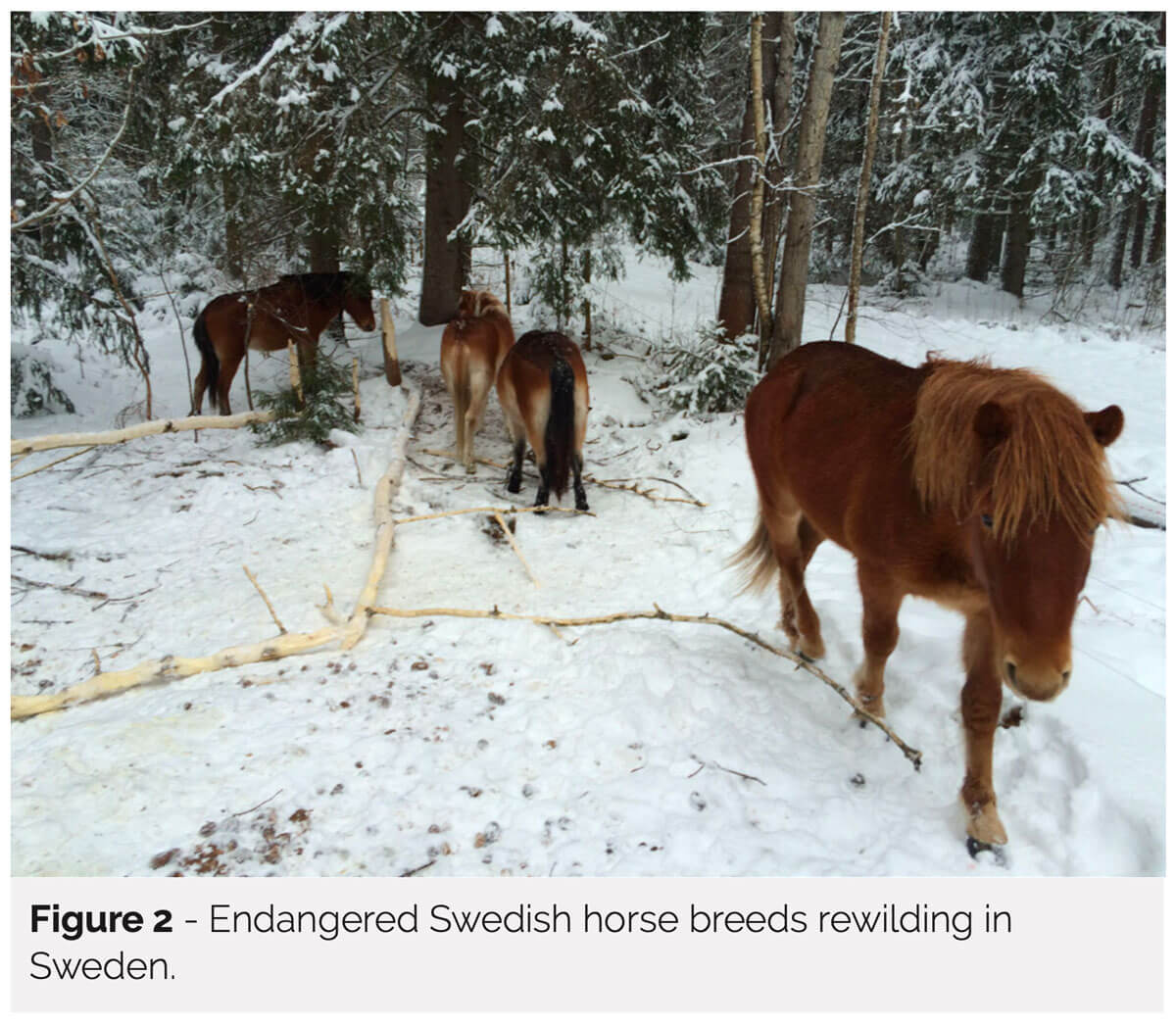Photo credit: Bison rewilding in Riaño, León (Spain). Photos taken by Pelayo García.
Rewilding Prerequisites: An Ecocentric Approach
BY PABLO GARRIDO
Soul of the Wilderness
October 2024 | Volume 30, Number 2

Rewilding is increasingly gaining momentum as a conservation practice in Europe. The concept was originally developed to support the restoration of large, connected wilderness areas to restore key ecological processes and functions by reintroducing keystone species such as large carnivores (Soulé and Noss 1998), yet multiple definitions have emerged since (see Corlett 2016). Trophic rewilding is currently the main approach applied in Europe. It aims to restore trophic cascades to promote self-regulating biodiverse ecosystems (Svenning et al. 2016). From an ecocentric perspective, the reintroduction of previously extinct species or ecological replacements, as well as their associated processes and functions, are fundamental to restore functional ecosystems and may partly tackle current biodiversity and climate crises.
Global human expansion since the late Pleistocene has been proposed as the main driver for megafaunal declines, and therefore the reversal of such pervasive effects through rewilding seems logical. However, the vast majority of terrestrial land globally is encroached by humans, rendering little space for sympatric, large-bodied mammals to roam freely. In places where wildlife populations are increasing, there is a parallel increase in (perceived) human-wildlife conflict. At best, these conflicts are resolved with multiple mitigation strategies to minimize negative effects on anthropogenic interests. In less tolerant scenarios, recolonized animals are just killed. This leads naturally to the question: What actually needs rewilding?

Once our economic or any other interests are threatened, multiple human-wildlife conflicts may simultaneously arise. For instance, in the Assam region of northeast India, tea plantations have spread without any consideration to wildlife. This leads to human settlements coming into conflict with the last migrating Asian elephants, although such seasonal movements may predate our own human existence as a species. In Europe, the increase of the wolf population in Sweden and Norway are good examples of how we vehemently oppose changes to the “traditional” management practices we have performed for the last century, yet these animals that are now recolonizing their historical distributional ranges were part of European ecosystems for million years. In Norway, such opposition was ignited as a response to avoid changing extensive sheep herding practices. In Sweden, the killing of a few hunting dogs by wolves at moose (Alces alces) hunting events escalated tremendously the public debate about wolves, inducing the authorities to allow wolf hunting to “enhance” the species acceptance or tolerance but which clearly threatens this highly endangered population (Laikre et al. 2022).
In November 2019, a Wallenberg Foundation seminar on rewilding was held in Stockholm that presented rewilding as a new paradigm for nature conservation (Wallenberg Seminar 2019). It further discussed the state of the art of the science, appropriate reference baselines for ecosystem restoration, potential conflicts with cultural landscapes, and biodiversity in agricultural areas, as well as suitable targets and scales to implement a rewilding strategy in Sweden and elsewhere. However, none of the renowned speakers questioned nor reflected on the need for a fundamental change in humanity, in ourselves, to facilitate a significant positive global impact on nature, which we all depend on. Thus, despite good intentions, the rewilding phenomenon is limited at its core as an ecocentric-focused paradigm. We do not place enough responsibility upon humans to seriously question the way we currently live and behave. Neither do we fully examine the negative global effects of our actions, which are a mere reflection of our inner psychological conditioning that resonates outward with further detrimental effects on ourselves and others and on nature and global biodiversity at large.

Who told us we are the stewards of the planet and hold the power to decide the fate of all species? Today, we humans are the main species responsible for the ongoing planetary collapse due to our irresponsible nature-destructive behavior. I argue that what we really need to rewild is our minds and hence ourselves. We need to realize that animals and plants alike have the same right to exist, as recently exemplified by New Zealand in 2017 when that country passed a groundbreaking law granting personhood status to the Whanganui River. Yet are we not capable of respecting any natural being unless we force ourselves by stating it in a legal document? Can it be considered as a true understanding of respect to any other being or natural entity when it is enforced? We also need to understand the dynamic nature of ecosystems and accept it without creating delusion conflicts (we perceive any threat to our commodities, to our “business as usual,” as a conflict) when our commodities and economic interests are compromised. Such an understanding may guide humankind to newer, humbler, ecocentric human–nature interactions and therefore more harmonious futures.

The essential and much-needed change of humanity may unfold by self-reflection and inner inquiry, practices purposely neglected in modern societies and educational programs. We may then realize that to live is the only purpose of life, and therefore current paradigms, worldviews, and relationships to nature and other sentient beings (including ourselves) will irremediably automatically change. Such an understanding may facilitate or manifest a deep ecological principle; that is, that we are nature and nature is us, and therefore any harm to nature is harm to ourselves. This necessity for a human behavioural change has already been emphasized from different disciplines and argued to be crucial and urgent (Cowling 2014; Reddy et al. 2017).
As humans, we have the ability to decide whether to coexist within the planet or not. This is not only an opportunity but also represents a huge neglected responsibility. No other species have the luxury to “complain” when our actions decimate their populations or transform the only habitats they have for survival. The reverse, however, applies in all cases of nature affecting humans (manifesting the prevailing human–nature dichotomy). Because of these internal inconsistencies and hypocritical behaviors, are we actually prepared to rewild European landscapes? Shouldn’t we need to rewild ourselves first? Today, the UN Decade on Ecosystem Restoration (2021–2030), and the recently passed European Law for Nature Restoration provide the greatest opportunity to take widespread and immediate action to tackle ecosystem degradation. Currently, 80% of EU habitats are highly damaged or degraded. The law thus regulates this urgent need for ecosystem restoration by setting legally binding biodiversity and restoration targets for all member states. By 2030, at least 20% of forest and grassland habitats as well as wetlands, rivers, lakes, and coral reefs need to achieve a favorable conservation status, increasing to 60% by 2040 and, 90% by 2050, in accordance with international commitments – in particular the UN Kunming-Montreal Global Biodiversity framework. But can we possibly do that and seize this opportunity without de-domesticating or rewilding ourselves first?
Acknowledgments
I would like to thank to the participants of a seminar held in Stockholm on rewilding as a new paradigm for nature conservation organized by the Wallenberg Foundation for inspiration.
PABLO GARRIDO is a faculty member in the Department of Anatomy, Physiology and Biochemistry at the Swedish University of Agricultural Sciences; email: garrido.pei@gmail.com.
References
Cowling, R. M. 2014. Let’s get serious about human behavior and conservation. Conservation Letters 7: 147–148.
Laikre, L., F. W. Allendorf, J. Aspi, C. Carroll, L. Dalén, R. Fredrickson, C. H. Wheat, P Hedrick, K. Johannesson, M. Kardos, R. O. Peterson, M. Phillips, N. Ryman, J. Räik könen, C. Vilà, C. W. Wheat, C. Vernesi, and J. A. Vucetich. 2022. Planned cull endangers Swedish wolf population. Science 377(6602): 162–162.
Reddy, S. M. W., J. Montambault, Y. J. Masuda, E. Keenan, W. Butler, J. R. B. Fisher, S. T. Asah, and A. Gneezy. 2017. Advancing conservation by understanding and influencing human behavior. Conservation Letters 10: 248–256.
Soulé, M., and R. Noss. 1998. Rewilding and biodiversity: Complementary goals for continental conservation. Wild Earth 8: 18–28.
Svenning, J.-C., P. B. M. Pedersen, C. J. Donlan, R. Ejrnæs, S. Faurby, M. Galetti, D. M.\ Hansen, B. Sandel, C. J. Sandom, J. W. Terborgh, and F. W. M. Vera. 2016. Science for a wilder Anthropocene: Synthesis and future directions for trophic rewilding research. Proceedings of the National Academy of Sciences 113(4): 898–906.
Wallenberg Seminar. 2019. Rewilding as a new paradigm for nature conservation? https://www.ksla.se/wp-content/ uploads/2019/09/2019-11-19-Rewilding_ Programme.pdf.
Read Next
Missing the Forest for the Algorithm
What is the value of wilderness? Well, what you have just completed reading is the “value of wilderness” as described by ChatGPT 3.5.
Trusting Tech and Wilderness in the 21st Century
A Response to Keeling’s The Trouble with Virtual Wilderness
Benefits and Trade-Offs of Environmental DNA (eDNA) in Wilderness Character Monitoring
Visitor Perspectives on Removing and Maintaining Dams in Wilderness



